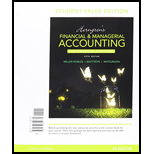
Concept explainers
(1)
Accounts receivable
Accounts receivable refers to the amounts to be received within a short period from customers upon the sale of goods and services on account. In other words, accounts receivable are amounts customers owe to the business. Accounts receivable is an asset of a business.
Bad debt expense:
Bad debt expense is an expense account. The amounts of loss incurred from extending credit to the customers are recorded as bad debt expense. In other words, the estimated uncollectible accounts receivable are known as bad debt expense.
Allowance method:
It is a method for accounting bad debt expense, where uncollectible accounts receivables are estimated and recorded at the end of particular period. Under this method,
To journalize: The September month transactions using allowance method.
(2)
Direct write-off method:
Under this method, accounts would be written off only when it is determined that the receivables from a customer remain uncollectible.
Write-off:
Write-off refers to deduction of a certain amount from accounts receivable, when it becomes uncollectible.
To journalize: The September month transactions using direct-write off method.
(3)
To Show: The amount of bad debts expense that will be reported on the income statement under each of the two methods, and describe which amount best matches expenses with revenue.
(4)
To identify: The amount that would be reported as net accounts receivable on the
Want to see the full answer?
Check out a sample textbook solution
Chapter 8 Solutions
Horngren's Financial & Managerial Accounting, The Financial Chapters (Book & Access Card)
- Please provide the answer to this general accounting question using the right approach.arrow_forwardI am searching for the accurate solution to this general accounting problem with the right approach.arrow_forwardD&G ENTERPRISES ISSUES BOND WITH A $1,000 FACE VALUE THAT MAKES COUPON PAYMENTS OF $10 EVERY 3 MONTHS. WHAT IS THE COUPON RATE? A. 1% B. 4% C. 6% D. 8% E. 12%arrow_forward
- Can you help me solve this general accounting question using the correct accounting procedures?arrow_forwardI am looking for a reliable way to solve this financial accounting problem using accurate principles.arrow_forwardCan you explain the correct approach to solve this general accounting question?arrow_forward
- Can you demonstrate the proper approach for solving this financial accounting question with valid techniques?arrow_forwardCan you solve this general accounting problem using accurate calculation methods?arrow_forwardA company had an income of $60,000 using absorption costing for a given period. Beginning and ending inventories for that period were 13,000 units and 18,000 units, respectively. Ignoring income taxes, if the fixed overhead application rate was $3.00 per unit, what was the income using variable costing? A. $75,000. B. $60,000. C. $45,000. D. Not sufficient information to determine.arrow_forward
- Can you solve this general accounting problem with appropriate steps and explanations?arrow_forwardAn asset has a book value of $22,500 on December 31, Year 4. The asset has been depreciated at a straight-line rate of $5,000 per year. If the asset is sold on December 31, Year 4 for $19,000, what should the company record? • a. A loss on sale of $3,500 • b. A gain on sale of $3,500 . c. Neither a gain nor a loss is recognized . • d. A loss on sale of $1,000 e. A gain on sale of $1,000arrow_forwardThe audited accounts of Rattle Limited for year-end December 31, 2013, show a profit of $2,400,000 after charging the following: Depreciation $380,000 Legal fees $723,000 Bad debts $67,000 Donations $55,400 Accrued interest $51,000 Foreign travel $75,000 Repair and maintenance $216,000 Premium on insurance $88,000 Other Information: a. - Legal fees of $723,000 are for expenses in respect of the recovery of debts. b. - The company made donations of $55,400 to a registered charity. c. - The bad debt expense is a percentage of debtors at year-end. d. - Foreign travel expense was for a trip by the marketing manager to meet with potential buyers. e. - The capital allowances have been calculated at $142,000 f. - The premium paid of $88,000 was on insurance for the business’ property. g. - There were acquisition expenses of $45,000 associated with the expansion of the business. What is Rattle Ltd.’s corporate tax liability?…arrow_forward
 Financial Accounting: The Impact on Decision Make...AccountingISBN:9781305654174Author:Gary A. Porter, Curtis L. NortonPublisher:Cengage Learning
Financial Accounting: The Impact on Decision Make...AccountingISBN:9781305654174Author:Gary A. Porter, Curtis L. NortonPublisher:Cengage Learning Intermediate Accounting: Reporting And AnalysisAccountingISBN:9781337788281Author:James M. Wahlen, Jefferson P. Jones, Donald PagachPublisher:Cengage LearningPrinciples of Accounting Volume 1AccountingISBN:9781947172685Author:OpenStaxPublisher:OpenStax College
Intermediate Accounting: Reporting And AnalysisAccountingISBN:9781337788281Author:James M. Wahlen, Jefferson P. Jones, Donald PagachPublisher:Cengage LearningPrinciples of Accounting Volume 1AccountingISBN:9781947172685Author:OpenStaxPublisher:OpenStax College College Accounting, Chapters 1-27AccountingISBN:9781337794756Author:HEINTZ, James A.Publisher:Cengage Learning,
College Accounting, Chapters 1-27AccountingISBN:9781337794756Author:HEINTZ, James A.Publisher:Cengage Learning, College Accounting (Book Only): A Career ApproachAccountingISBN:9781337280570Author:Scott, Cathy J.Publisher:South-Western College Pub
College Accounting (Book Only): A Career ApproachAccountingISBN:9781337280570Author:Scott, Cathy J.Publisher:South-Western College Pub





